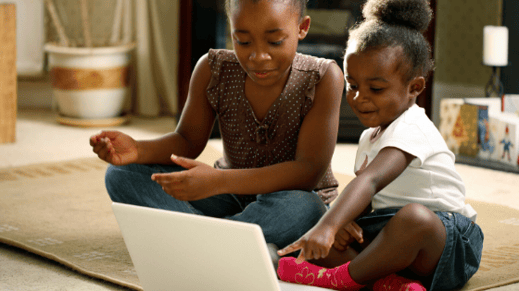
My kids have been home since March 14th. Sure, not technically home the whole time, we’ve taken many walks and explored just about every park our area has to offer. But they haven’t been to a store, or a friend’s house, or school.
For my first grader, not going to school has been hard. She’s always loved school. She used to run into her preschool teacher’s arms and say “I love you” as a morning greeting and she talked about her kindergarten teacher like she was a celebrity. So I knew school closing would be hard on her. However, over the last two and a half months, she’s maintained a relationship with her teachers and her school community, without leaving home.
Using Video to Connect with Students
Her school, like many others, has used Zoom and GoogleMeet to have class meetings. She also gets to read to her assistant teacher and meet one-on-one with her teacher once a week. They’ve done car parades to visit the students and organized a student car parade to honor a teacher who was leaving. These have all been incredible and show the constant dedication of the school staff. But one of the things I’ve been most surprised by is their YouTube videos. Every week her teachers share read-alouds, phonics games, morning meetings, math lessons, sing-alongs, writing prompts, and even PE and Art classes, And she loves seeing her teachers on the screen.
With a weekly email that has recommended YouTube links, families have easy access to content that:
-
- Doesn't require them to download anything or learn a new platform
- Is 3-8 minutes in length, to suit the children’s attention span
- Has opportunities for child and family engagement
Most importantly, it’s content that is delivered by someone she has a relationship with already—her teachers.
Here are clips they’ve agreed to share, that I found were examples of how teachers can provide high-quality interactions during remote learning.
Emotional Support in Videos
With the CLASS tool, when we talk about Emotional Support, we’re looking at the degree to which teachers develop positive relationships with children and are sensitive to children’s needs. This would mean teachers are helping children develop an enjoyment of and excitement about learning, a feeling of comfort, and an appropriate level of autonomy.
You can see it in their videos when teachers are creating a Positive Climate and showing Teacher Sensitivity by:
-
- Showing positive affect, through smiling and laughing
- Using positive communication and showing verbal affection (“I really miss you”)
- Being aware and responsive to the fact that many children may be having a hard time at home
Many also bring in their family members to carry on routines like Morning Meeting that offer opportunities for student expression and student focus while bringing comfort.
Classroom Organization
The Classroom Organization domain is broad but looks for ways the teacher organizes and manages the students' behavior, time, and attention. Now obviously the YouTube videos can’t help prevent and redirect misbehavior while my daughter is at home (I wish!) but they can maximize learning time, have brief transitions, offer a variety of modalities, and keep students consistently interested and involved.
Notice how the teacher:
-
- Offers a variety of modalities for engagement, including auditory, visual, and movement (tapping, pointing)
- Brings in creative materials, using toys kids would use or play with
- Has clear instructions and effective pacing
- Consistently focuses the students’ attention on the learning objective, telling them what they are going to learn, and then summarizing what they did
Instructional Support
The Instructional Support domain looks at the ways teachers effectively support cognitive and language development by promoting higher-order thinking skills, extending learning through feedback and scaffolding, and facilitate and encourage students’ language. Of course, some of this is quite difficult to achieve in a video, like having frequent conversations or back-and-forth exchanges. However, watch how in this short Spanish lesson, the teacher:
-
- Relates concepts to the students’ lives (they’ve likely seen butterflies in spring) and makes connections to the real world
- Introduces new language, like migrate, connecting it to familiar words
- Repeats the new words
- Maps her actions with language (“fold it back, and forward”)
The past few months have fundamentally changed the way students and teachers interact. Some of these changes will likely continue, even after students return to the classroom. One thing will remain constant though—positive interactions with children matter. They may remain more difficult, but they are possible. These videos, done by teachers who had no time to plan or prepare to teach from their own homes, show just that.

